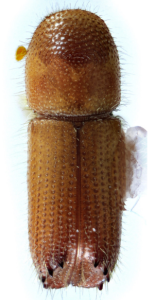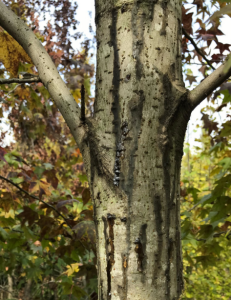One of the most abundant hardwood trees in the southeastern United States, American sweetgum (Liquidambar styraciflua L.) has a wide distribution ranging from southwestern Connecticut to central Florida. The origin of it’s botanical nomenclature can be further broken down from the Latin liquidus, meaning fluid, the Arabic ambar, a reference to the terebinthine liquid that can exude from the tree, and sytraciflua, an older generic name which briefly translates to flowing with storax, or plant resin.

Reaching heights of up to 70 ft. in cultivated areas, and 150 ft. in the wild, and a trunk diameter of ~2-3 ft., these native trees can live up to 200+ years under favorable conditions. With it’s attractive foliage and aromatic flowers, these trees are incredibly hurricane resistant and also serve as a larval host plant for the beloved Luna moth (Actias luna). In addition, it also serves as one of the most important hardwoods utilized for an array of carpentry materials.
While sweetgum trees are currently susceptible to many pests including bagworms, fall webworms, numerous scale insects, and both wood and root boring beetles – there is a additional new pest of concern.

The sweetgum inscriber (Acanthotomicus suncei), is a small bark beetle native to China. In 2013, it was detected in Shanghai eliciting extensive damage and eventual death on cultivated American sweetgum trees of the area. While it has not yet been detected here in the United States, there is mounting concern over its potential introduction and subsequent spread due to substantial levels of trade.
Acanthotomicus suncei is small (2.5 mm in length) and its body is orange to light brown in color. Infesting areas of the inner bark and phloem tissue of healthy trees, it can primarily be found in regions of the trunk, but has also been reported in twig and branch areas as well. This beetle has two generations per year, with adults typically emerging in April and populations peaking from May-July.
As many bark beetle species are intertwined with the cultivation and spread of fungal pathogens, it is also of great importance to assess these associations. Zhang et al., has determined that the most common fungal species isolated from these beetles is Geosmithia luteobrunnea, which is not a systemic pathogen but does create lesions over time. Further research is underway on the impact of this fungal association with these bark beetles.

Estimated potential losses of American sweetgum are ~$4.6 million annually. This figure does not take into account losses from residential and commercial areas where sweetgum is widely incorporated into the landscape, along with the detriment caused to Luna moths and other wildlife who depend on this species.
For more information on this pest, be sure to check out the latest FDACS-DPI Pest Alert, along with the following materials:
Gao, L. and Cognato, A. I. (2018). Acanthotomicus suncei, a new sweetgum tree pest in China (Coleoptera: Curculionidae:
Scolytinae: Ipini). Zootaxa 4471(3): 595–599.
Gao, L., Li, Y., Wang, Z.X., Zhao, J., Hulcr, J., Wang, J.G., Li, Y.Z. and Ju, R.T. (2021). Biology and associated fungi of an emerging bark beetle pest, the sweetgum inscriber Acanthotomicus suncei (Coleoptera: Curculionidae). Journal of Applied Entomology
145(6): 508–517.
Susaeta, A., Soto, J.R., Adams, D.C. and Hulcr, J. (2017). Expected timber-based economic impacts of a wood-boring beetle
(Acanthotomicus sp.) that kills American sweetgum. Journal of Economic Entomology 110(4): 1942–1945.
Zhang, X., Li Y., Si, H., Zhao, G., Kolařík, M., Hulcr, J., Jiang, X., Dai, M., Chang, R. (2022). Geosmithia species associated with bark beetles from Southern China, with the description of eleven new species. Frontiers of Microbiology, in press.
 3
3
